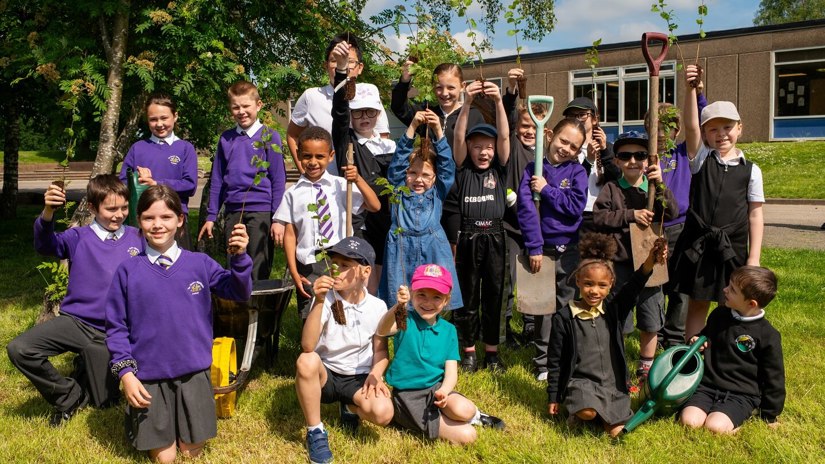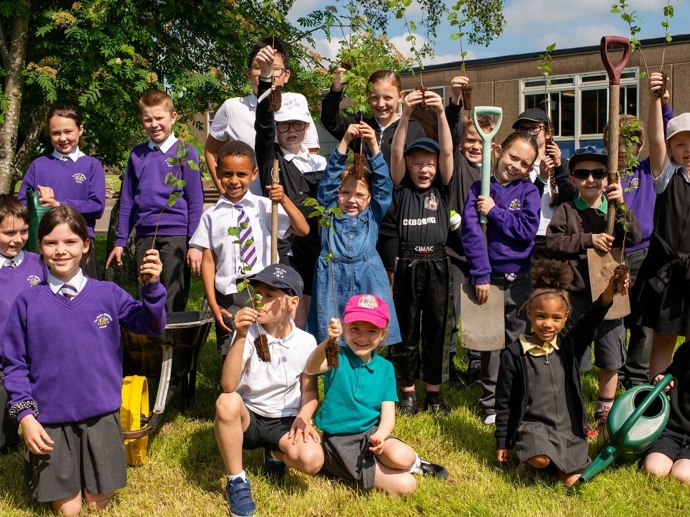

Free trees for schools and communities
Trees help people and nature thrive and we need more of them in the ground. That’s why we’re giving thousands away free to schools, councils, clubs and more.
Setting up a new community wood involves costs, from buying the wood or some land, to sourcing trees and on-going maintenance. If you want to seek funding, it's essential to plan your finances as well as possible.
When you first set up your community group you'll need to assess your goals and likely costs, and put together a business plan. This is a basic need for your group’s accounts or treasurer’s report and most grant providers need to see it too.
Appoint a treasurer and ensure your plan covers both capital and revenue. Capital covers the cost of physical assets such as purchasing land or tools. Revenue covers day-to-day spending on maintenance or contractors. You’ll also need to list your income and annual outgoings.
You could also tap into other, non-financial ways of securing resources. Perhaps there’s a skilled coppice worker willing to help in your wood in exchange for a share of the produce?
If you’re planting a new wood, extending an existing one or planting hedgerow, you’ll need saplings. There are a few ways you can source them.
We want to make sure everybody has the chance to plant a tree. So each year we give away hundreds of thousands of community tree packs to groups across the UK. Find out if you are eligible.
If you’re looking to plant lots of trees we can offer funding and a team of expert advisers to help you achieve your goals.


Trees help people and nature thrive and we need more of them in the ground. That’s why we’re giving thousands away free to schools, councils, clubs and more.
Local fundraising has the advantage of raising awareness in your community wood.
There are four approaches to finding funds: donations, fundraising activities, grants and loans. You’ll need a clear fundraising ask with a deadline if necessary – often a sense of urgency can help inspire support.
These can come from many sources. You could start by approaching your existing support base such as neighbours, local businesses and residents’ groups to establish whether they’re willing to donate.
You could also run a community appeal to encourage donations from wealthy individuals and organisations. This can be via letter, leaflet or pledge form outlining your project and asking for contributions. Perhaps the local newspaper will print an article on your plans, complete with donation form. Include how much you need to raise, how the money will be spent, and how people can give.
And don’t forget that if your group is registered as an official charity, you can claim Gift Aid on donations received from individuals: that’s an extra 25% every time a UK taxpayer donates and opts in.
Your fundraising drive can be as creative as you want it to be. And if you already have access to your own wood, it’s a great resource: from scavenger hunts to food festivals and cake sales, nature walks or sponsored cycles. How about an outdoor quiz or stargazing evening?
Sponsored events and fun-days tend to achieve modest sums, but they’re great for building your group’s profile and boosting community support. Bigger funding opportunities may come later.
Some companies run schemes where they’ll match-fund cash raised by the efforts of their employees. So if any of your group’s employers offer this, it could double your money.
You’re more likely to be successful if you understand what funders are interested in and what similar projects they’ve supported.
It’s worth spending some time searching for established organisations that offer grants that fit with your group’s aims.
Search online for grants available from larger organisations such as the Forestry Commission, National Lottery, Landfill Communities Fund or Veolia. Or you may find there’s money available from local trusts and charities.
Your community woodland group may be able to secure a loan from a bank, building society or private lender. A business case will be required – and you’ll need to repay the loan in the agreed timeframe and with interest.
Your parish council can also apply for a loan via the Public Works Loan Board, and grant you the money received. The council can then add repayments onto the parish precept, its portion of council tax payments.
Or perhaps you can borrow from an individual at low interest rates. Get professional help to draw up a loan agreement, which could specify that lenders won’t be repaid for a specific period. Some lenders ask for ‘security’, something of equal value if you can’t repay their loan. Others may want a guarantor, someone with the money to repay if your group cannot.
You could ask group members to pay an annual subscription, as do many clubs and societies. Or you could offer community shares to stakeholders. This is now a common way to raise start-up capital, including for land purchases.
Buyers might be looking for a return on their share, or they may be happy to invest on the basis they’re receiving a non-financial reward, like better woodland access and an improved locality.
Shares can take many guises and are only available for groups with certain legal structures, notably Industrial and Provident Societies and Community Interest Companies, which issue ‘withdrawable shares’ which can only be redeemed with the consent of the group, so don’t carry the same burden of repayment as a loan.
Other ideas include charging an annual fee to groups or individuals who spend time in your wood for recreational or commercial ends — perhaps a horse-riding society or forest gym owner. You might consider cashing in on woodland products or services such as sustainably harvested timber and firewood.
Or try crowdfunding, where members of the public are invited to chip in to a fundraising pot, usually via an internet platform.